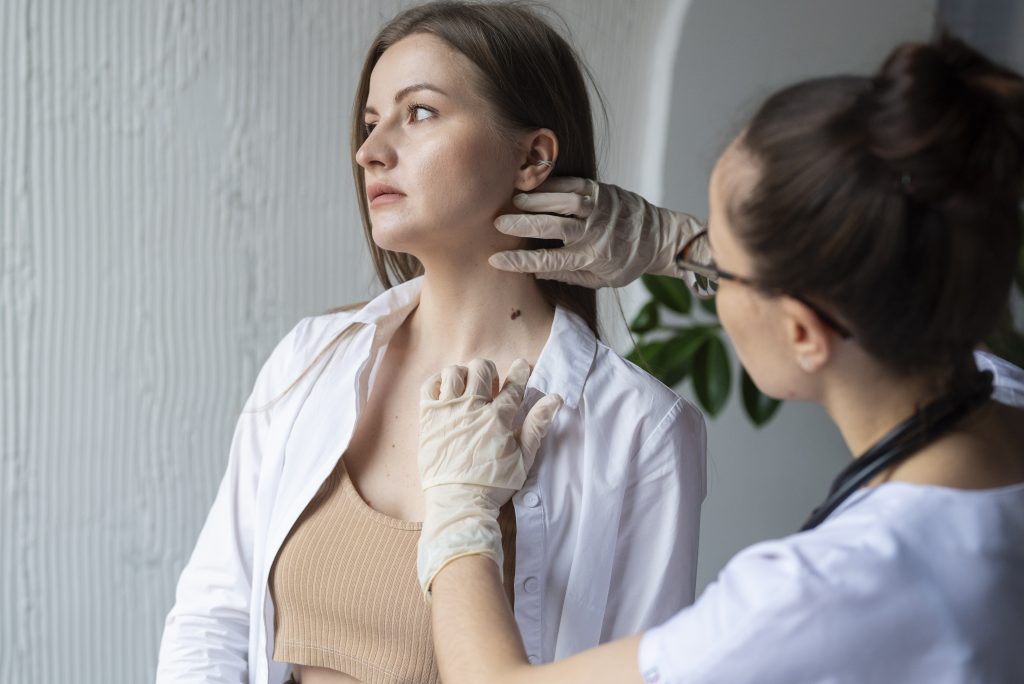
Skin Cancer Treatment in Concord & Charlotte, North Carolina
Skin cancer is the most common type of cancer in the United States, and prevention and early detection are key. Scheduling an annual skin cancer screening is very important. Additionally, if you spot a new mole on your body, or if you have a mole that is changing in size, shape, or color, it’s important to have it examined. The physicians at Dermatology Group of The Carolinas, with locations in Concord, Salisbury, and Huntersville, NC, are experts in skin cancer.
Skin Cancer
Skin cancer is typically caused by repeated exposure to ultraviolet rays that come from the sun or, in some cases, tanning beds. Ultraviolet rays damage the skin, and that damage shows up in the short term as sunburn. But over time, ultraviolet ray damage can lead to DNA changes in the skin cells that lead to cancer. There are three primary types of skin cancer: basal cell carcinoma, squamous cell carcinoma, and melanoma.
Basal Cell Carcinoma
Basal cell carcinoma is the most common type, and it frequently develops on parts of the body that have been exposed to the sun, like the face, scalp, ears, legs, and arms. Basal cell carcinoma can take the form of a small bump, a scaly lesion, a small wound, a red patch, or a sore. This type of cancer, which may bleed occasionally, grows very slowly and has a high cure rate.
Squamous Cell Carcinoma
Squamous cell carcinoma also appears frequently on sun-exposed skin, but it can develop anywhere on the body. It typically appears as a rough, scaly patch or as a nodule. Squamous cell carcinoma also has a high cure rate, although if left untreated it can grow and spread to other parts of the body.
Melanoma
Melanoma is the rarest form of skin carcinoma, but it is also the most serious. Melanoma develops when the cells that produce the pigment that gives skin color become cancerous. This type of cancer can appear anywhere on the body and may show up as a new growth or a change in a mole.
If it is caught early, melanoma can usually be cured. But once it has penetrated deeply into the skin or spread to other parts of the body, it can be hard to treat and may be deadly.
How Is Skin Cancer Treated?
Cryosurgery
Cryosurgery involves the spraying of liquid nitrogen onto the cancerous site, which freezes and destroys the cancer. Over the next 14 days, a scab will form on the site. When the scab eventually falls off, it will take the cancerous cells with it. This treatment is best for precancerous lesions or for cancers that have not spread.
Curettage and Electrosurgery
Small, cancerous sites may sometimes be scraped away by your dermatologist using a treatment known as curettage. Electrosurgery, which involves the use of an electric current to burn tissue, follows curettage and eliminates any remaining cancer cells. This type of surgery is usually performed on small, clearly defined cancers.
Excision
Excision involves the removal of the cancerous site along with some of the surrounding tissue. The skin is numbed in advance and a surgical knife is used to excise cancer. This conventional method of surgery can be used to remove all three types of cancer.
Mohs Surgery
Mohs surgery is performed on basal cell and squamous cell cancers on the head and neck. Mohs surgery is popular not only because of its success rate, but because it spares as much healthy tissue as possible, minimizing the cosmetic impact on the patient. During a Mohs procedure, your dermatologist will remove single layers of the skin, and examine each with a microscope. This process will continue until the area around the site is determined to be cancer free.
Mohs surgery is an advanced technique that takes time, but it is very successful at eliminating cancer with minimal impact on the patient’s appearance.
Radiation Therapy
Radiation therapy involves the use of x-rays to kill cancerous cells. This treatment is similar to the process of undergoing a traditional x-ray, but the radiation level is higher and targets the cancerous site. Radiation therapy is a way of treating cancerous tumors that are very large or located in an area that makes removal difficult. Radiation is also sometimes combined with other treatments
Chemotherapy Cream
A chemotherapy cream called Efudix can be applied topically by patients to the cancer site. Efudix can effectively treat superficial skin cancers in the very top layer of the skin. Patients typically apply the cream twice a day for three or four weeks.
Photodynamic Therapy
Precancerous skin lesions, which are often referred to as actinic keratoses, appear as rough, scaly patches on the skin and are frequently treated with photodynamic therapy. This non-invasive therapy kills cancer cells with a combination of a light-sensitive drug and a bright light. Your dermatologist will put a cream containing a light-sensitive chemical on the cancerous site and then use a special light to activate the medicine.
Skin Grafting
If a large section of skin is removed as part of a cancer surgery, your dermatologist may use a skin graft to repair the site. When performing a graft, healthy skin is taken from another part of the body. A skip flap, which involves using healthy skin adjacent to the cancer site for the repair, is also an option.
Your Trusted Partner in Skin Health
The skin is the largest organ of the body, and it’s important to keep it healthy and cancer-free. That’s why it’s essential that you pay attention to your skin and undergo regular screenings, particularly if you have fair skin, have experienced multiple sunburns, or have a family history of skin cancer. The Dermatology Group of The Carolinas, with locations in Concord, Salisbury, and Huntersville, NC, can be a trusted partner in ensuring your skin health.

